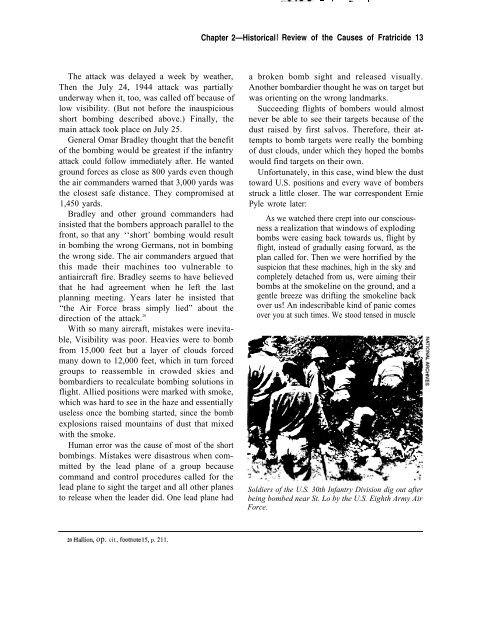Who Goes There: Friend or Foe? - Federation of American Scientists
Who Goes There: Friend or Foe? - Federation of American Scientists
Who Goes There: Friend or Foe? - Federation of American Scientists
You also want an ePaper? Increase the reach of your titles
YUMPU automatically turns print PDFs into web optimized ePapers that Google loves.
The attack was delayed a week by weather,<br />
Then the July 24, 1944 attack was partially<br />
underway when it, too, was called <strong>of</strong>f because <strong>of</strong><br />
low visibility. (But not bef<strong>or</strong>e the inauspicious<br />
sh<strong>or</strong>t bombing described above.) Finally, the<br />
main attack took place on July 25.<br />
General Omar Bradley thought that the benefit<br />
<strong>of</strong> the bombing would be greatest if the infantry<br />
attack could follow immediately after. He wanted<br />
ground f<strong>or</strong>ces as close as 800 yards even though<br />
the air commanders warned that 3,000 yards was<br />
the closest safe distance. They compromised at<br />
1,450 yards.<br />
Bradley and other ground commanders had<br />
insisted that the bombers approach parallel to the<br />
front, so that any ‘‘sh<strong>or</strong>t’ bombing would result<br />
in bombing the wrong Germans, not in bombing<br />
the wrong side. The air commanders argued that<br />
this made their machines too vulnerable to<br />
antiaircraft fire. Bradley seems to have believed<br />
that he had agreement when he left the last<br />
planning meeting. Years later he insisted that<br />
“the Air F<strong>or</strong>ce brass simply lied” about the<br />
direction <strong>of</strong> the attack. 20<br />
With so many aircraft, mistakes were inevitable,<br />
Visibility was po<strong>or</strong>. Heavies were to bomb<br />
from 15,000 feet but a layer <strong>of</strong> clouds f<strong>or</strong>ced<br />
many down to 12,000 feet, which in turn f<strong>or</strong>ced<br />
groups to reassemble in crowded skies and<br />
bombardiers to recalculate bombing solutions in<br />
flight. Allied positions were marked with smoke,<br />
which was hard to see in the haze and essentially<br />
useless once the bombing started, since the bomb<br />
explosions raised mountains <strong>of</strong> dust that mixed<br />
with the smoke.<br />
Human err<strong>or</strong> was the cause <strong>of</strong> most <strong>of</strong> the sh<strong>or</strong>t<br />
bombings. Mistakes were disastrous when committed<br />
by the lead plane <strong>of</strong> a group because<br />
command and control procedures called f<strong>or</strong> the<br />
lead plane to sight the target and all other planes<br />
to release when the leader did. One lead plane had<br />
20 l-l~lio~ op. cit., fOOtIIOte 15, p. *11.<br />
Chapter 2—Hist<strong>or</strong>ical<br />
. .<br />
Review <strong>of</strong> the Causes <strong>of</strong> Fratricide 13<br />
a broken bomb sight and released visually.<br />
Another bombardier thought he was on target but<br />
was <strong>or</strong>ienting on the wrong landmarks.<br />
Succeeding flights <strong>of</strong> bombers would almost<br />
never be able to see their targets because <strong>of</strong> the<br />
dust raised by first salvos. <strong>There</strong>f<strong>or</strong>e, their attempts<br />
to bomb targets were really the bombing<br />
<strong>of</strong> dust clouds, under which they hoped the bombs<br />
would find targets on their own.<br />
Unf<strong>or</strong>tunately, in this case, wind blew the dust<br />
toward U.S. positions and every wave <strong>of</strong> bombers<br />
struck a little closer. The war c<strong>or</strong>respondent Ernie<br />
Pyle wrote later:<br />
As we watched there crept into our consciousness<br />
a realization that windows <strong>of</strong> exploding<br />
bombs were easing back towards us, flight by<br />
flight, instead <strong>of</strong> gradually easing f<strong>or</strong>ward, as the<br />
plan called f<strong>or</strong>. Then we were h<strong>or</strong>rified by the<br />
suspicion that these machines, high in the sky and<br />
completely detached from us, were aiming their<br />
bombs at the smokeline on the ground, and a<br />
gentle breeze was drifting the smokeline back<br />
over us! An indescribable kind <strong>of</strong> panic comes<br />
over you at such times. We stood tensed in muscle<br />
Soldiers <strong>of</strong> the U.S. 30th Infantry Division dig out after<br />
being bombed near St. Lo by the U.S. Eighth Army Air<br />
F<strong>or</strong>ce.
















